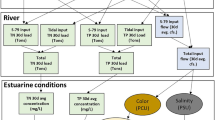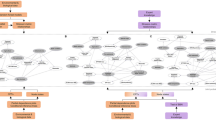Abstract
Wetlands are productive and diverse habitats for native fish but can be highly degraded, particularly in the Murray-Darling Basin (MDB), south-eastern Australia. Wetland management requires tools and processes that facilitate the synthesis and application of knowledge for decisions concerning the allocation of environmental water to wetlands to improve environmental outcomes. This paper describes the development of a Decision Support Tool (DST), based on a Bayesian Network designed to provide the best available science and support adaptive management of environmental flows into wetlands. The DST predicts the probability of improvements in fish population health as defined by abundance, population structure and fish condition for introduced common carp and three native species of fish: carp gudgeon, Australian smelt, and golden perch. Model sensitivity and validation showed that fish response varied depending on model inputs, but that responses from the DST were an accurate reflection of fish responses in wetlands based on field data. Ultimately, the success of this DST is dependent on its adoption by wetland managers. Throughout the entire development process, adoption of the DST has been promoted through engagement with managers and subsequently, through initiatives to integrate it into current management initiatives.


Similar content being viewed by others
References
Acreman M, Dunbar MJ (2004) Defining environmental river flow requirements - a review. Hydrology and Earth System Sciences 8:861–876
Arthington AH, Bunn SE, Poff NL, Naiman RJ (2006) The challenge of providing environmental flow rules to sustain river ecosystems. Ecological Applications 16:1311–1318. doi:10.1890/1051-0761(2006)016[1311:TCOPEF]2.0.CO;2
Ausseil AGE, Dymond JR, Shepherd JD (2007) Rapid mapping and prioritisation of wetland sites in the Manawatu-Wanganui Region, New Zealand. Environmental Management 39:316–325. doi:10.1007/s00267-005-0223-1
Australia, Commonwealth of (2007) Water Act. Pages 525, Commonwealth of Australia
Beesley L, Price A, King AJ, Gawne B, Nielsen DL, Koehn J, Meredith S, Vilizzi L, Hladyz S (2010) Watering floodplain wetlands in the Murray-Darling Basin for native fish. National Water Commission, Canberra, ACT
Boulton AJ, Brock MA (1999) Australian freshwater ecology processes and management. Gleneagles, Glen Osmond
Chen H, Zhao YW (2011) Evaluating the environmental flows of China’s Wolonghu wetland and land use changes using a hydrological model, a water balance model, and remote sensing. Ecological Modelling 222:253–260. doi:10.1016/j.ecolmodel.2009.12.020
DSEWPC (2010) Environmental Watering Locations. http://www.environment.gov.au/water/policy-programs/cewh/watering/index.html 22/01/2011 2011
Ebner B, Scholz O, Gawne B (2009) Golden Perch Maquaria ambigua are flexible spawners in the Darling River, Australia. New Zealand Journal of Marine and Freshwater Research 43:571–578
Fisher P, Ball T (2003) Tribal participatory research: mechanisms of a collaborative model. American Journal of Community Psychology 32:207–216
Goosen H, Janssen R, Vermaat JE (2007) Decision support for participatory wetland decision-making. Ecological Engineering 30:187–199. doi:10.1016/j.ecoleng.2006.11.004
Gregory R, Failing L, Higgins P (2006) Adaptive management and environmental decision making: a case study application to water use planning. Ecological Economics 58:434–447. doi:10.1016/j.ecolecon.2005.07.020
Gutreuter S (2004) Challenging the assumption of habitat limitation: an example from centrarchid fishes over an intermediate spatial scale. River Research and Applications 20:413–425
Hart B, Pollino C (2008) Increased use of Bayesian network models will improve ecological risk assessments. Human and Ecological Risk Assessment 14:851–853. doi:10.1080/10807030802235037
Hillman M, Brierley G (2002) Information needs for environmental-flow allocation: a case study from the Lachlan River, New South Wales, Australia. Annals of the Association of American Geographers 92:617–630
Jacobson RB, Janke TP, Skold JJ (2011) Hydrologic and geomorphic considerations in restoration of river-floodplain connectivity in a highly altered river system, Lower Missouri River, USA. Wetlands Ecology and Management 19:295–316. doi:10.1007/s11273-011-9217-3
Janssen R, Goosen H, Verhoeven ML, Verhoeven JTA, Omtzigt AQA, Maltby E (2005) Decision support for integrated wetland management. Environmental Modelling & Software 20:215–229. doi:10.1016/j.envsoft.2003.12.020
Junk WJ, Wantzen K. (2004) The flood pulse concept: New aspects, approaches and applications - an update. In: Welcomme R, Petr T (eds) Proceedings of the Second International Symposium on the Management of Large Rivers for Fisheries, vol. 2. Food and Agriculture Organization & Mekong River Commission FAO Regional Office for Asia and the Pacific, Bangkok, RAP, pp 117–49
Kauffman-Axelrod JL, Steinberg SJ (2010) Development and application of an automated GIS based evaluation to prioritize wetland restoration opportunities. Wetlands 30:437–448. doi:10.1007/s13157-010-0061-7
King AJ, Tonkin Z, Mahoney J (2009) Environmental flow enhances native fish spawning and recruitment in the Murray River, Australia. River Research and Applications 25:1205–1218. doi:10.1002/rra.1209
King AJ, Ward KA, O’Connor P, Green D, Tonkin Z, Mahoney J (2010) Adaptive management of an environmental watering event to enhance native fish spawning and recruitment. Freshwater Biology 55:17–31. doi:10.1111/j.1365-2427.2009.02178.x
Kingsford RT, Brandis K, Jenkins KM, Nairn L, Rayner TS. (2010) Measuring ecosystem responses to flow across temporal and spatial scales. In: Saintilan N,Overton I (eds) Ecosystem response modelling in the Murray-Darling Basin. CSIRO, pp 15–36
Koehn J, Brumley A, Gehrke PC (2000) Managing the impacts of carp. Bureau of Resource Sciences, Canberra
Kroon F, Robinson C, Dale A (2009) Integrating knowledge to inform water quality planning in the Tully-Murray basin, Australia. Marine and Freshwater Research 60:1183–1188
Lake PS, Bond N, Reich P (2007) Linking ecological theory with stream restoration. Freshwater Biology 52:597–615
Lancaster J (2000) The ridiculous notion of assessing ecological health and identifying the useful concepts underneath. Human and Ecological Risk Assessment 6:213–222
Marcot B, Steventon J, Sutherland G, McCann R (2006) Guidelines for developing and updating Bayesian belief networks applied to ecological modeling and conservation. Canadian Journal of Forest Research 36:3063–3074
Marsh N, Cuddy S (2010) Ecological modelling to support natural resource management. In: Ecosystem Response Modelling in the Murray-Darling Basin. CSIRO, Collingwood, Vic, pp 3–14
Marsh S, Pannell D (2000) Agricultural extension policy in Australia: the good, the bad and the misguided. The Australian Journal of Agricultural and Resource Economics 44:605–627
McCann R, Marcot B, Ellis R (2006) Bayesian belief networks: applications in ecology and natural resource management. Canadian Journal of Forest Research 36:3053–3062
McDaniels TL, Gregory RS, Fields D (1999) Democratizing risk management: successful public involvement in local water management decisions. Risk Analysis 19:497–510
MDBA (2010) Guide to the proposed Basin Plan: Technical background. Murray-Darling Basin Authority, Canberra, ACT
MDBA (2011) The living Murray story: one of Australia’s largets river restoration projects. Murray-Darling Basin Authority, Canberra, ACT
MDBC (2004) Native fish strategy for the Murray-Darling Basin 2003–2013. Murray-Darling Basin Commission, Canberra, ACT
Meredith S, Beesley L (2009) Watering floodplain wetlands in the Murray-Darling Basin to benefit fish: a discussion with managers. Heidelburg, Vic
Murphy B, Timbal B (2008) A review of recent climate variability and climate change in southeastern Australia. International Journal of Climatology 28:859–879
MWWG N (2010) NSW Murray Wetlands Working Group. http://www.mwwg.org.au /21/01/2011 2011
Nielsen D, Brock MA (2009) Loss of wetland diversity as a consequence of anthropogenic changes to water regime, salinity and climate. Climate Change 95:523–533
Nyberg J, Maarcot B, Sulyma R (2006) Using Bayesian belief networks in adaptive management. Canadian Journal of Forest Research 36:3104–3116. doi:10.1139/X06-108
Opperman JJ, Luster R, McKenney BA, Roberts M, Meadows AW (2010) Ecologically functional floodplains: connectivity, flow regime, and scale. Journal of the American Water Resources Association 46:211–226. doi:10.1111/j.1752-1688.2010.00426.x
Poff NL, Allan JD, Palmer MA, Hart DD, Richter BD, Arthington AH, Rogers KH, Meyers JL, Stanford JA (2003) Fiver flows and water wars: emerging science for environmental decision making. Frontiers in Ecology and the Environment 1:298–306
Pollino CA, Woodberry O, Nicholson A, Korb K, Hart BT (2007) Parameterisation and evaluation of a Bayesian network for use in an ecological risk assessment. Environmental Modelling & Software 22:1140–1152. doi:10.1016/j.envsoft.2006.03.006
Pusey BJ, Kennard MJ, Arthington AH (2004) Freshwater Fishes of North-Eastern Australia. CSIRO Publishing, Collingwood
Renken H, Mumby PJ (2009) Modelling the dynamics of coral reef macroalgae using a Bayesian belief network approach. Ecological Modelling 220:1305–1314
Richter BD, Thomas GA (2007) Restoring environmental flows by modifying dam operations. Ecology and Society 1212
Sarkar S, Illoldi-Rangel P (2010) Systematic conservation planning: an updated protocol. Natureza & Conservacao 8:19–26. doi:10.4322/natcon.00801003
Schreiber E, Bearlin A, Nicol J, Todd C (2004) Adaptive management: a synthesis of current understanding and effective application. Ecological Management and Restoration 5:177–182
Shenton W, Hart BT, Brodie J (2010) A Bayesian network model linking nutrient management actions in the Tully catchment (northern Queensland) with Great Barrier Reef condition. Marine and Freshwater Research 61:587–595. doi:10.1071/MF09093
Sparks R, Spink A (1998) Disturbance, succession and ecosystem processes in rivers and estuaries: effects of extreme hydrologic events. Regulated Rivers: Research & Management 14:155–159
Stanford JA, Ward JV, Liss WJ, Frissell CA, Williams RN, Lichatowich JA, Coutant CC (1996) A general protocol for restoration of regulated rivers. Regulated Rivers: Research & Management 12:391–413
Stuart IG, Jones M (2006) Large, regulated forest floodplain is an ideal recruitment zone for non-native common carp (Cyprinus carpio L.). Marine and Freshwater Research 57:337–347
SWC (2009) Coonancoocabil Lagoon water savings works, review of environmental factors draft v2. NSW State Water Corporation Sydney, NSW
Tockner K, Schiemer F (1997) Ecological aspects of the restoration strategy for a river-floodplain system on the Danube River in Austria. Global Ecology and Biogeography Letters 6:321–329. doi:10.2307/2997746
Vilizzi L, Price A, Gawne B, Beesley L, King AJ, Koehn J, Nielsen C (2011) Fish-in-wetlands decisions support tool: user manual. National Water Commission, Canberra, ACT
Walters C (2007) Is adaptive management helping to solve fisheries problems? AMBIO: A Journal of the Human Environment 36:304–307. doi:10.1579/0044-7447(2007)36[304:IAMHTS]2.0.CO;2
Walters C, Gunderson L, Holling CS (1992) Experimental policies for water management in the Everglades. Ecological Applications 2:189–202. doi:10.2307/1941775
Young WJ, Lam DCL, Ressel V, Wong IW (2000) Development of an environmental flows decision support system. Environmental Modelling & Software 15:257–265
Acknowledgments
The authors would like to thank the managers who contributed to the development of the DST, especially the members of the project steering committee; Deb Nias, Keith Ward, Mark Lintermans, Jack Chubb, Fern Hames, Wayne Tennant and Janet Pritchard and two anonymous manuscript reviewers. The authors also thank Drs Darren Baldwin and Clayton Sharpe for contributing to the development of the DSS in areas of their expertise. The project was funded by the Australian National Water Commission through their Raising National Water Standards Program. This Australian Government program supports the implementation of the National Water Initiative by funding projects that are improving Australia’s national capacity to measure, monitor and manage its water resources
Author information
Authors and Affiliations
Corresponding author
Rights and permissions
About this article
Cite this article
Gawne, B., Price, A., Koehn, J.D. et al. A Bayesian Belief Network Decision Support Tool for Watering Wetlands to Maximise Native Fish Outcomes. Wetlands 32, 277–287 (2012). https://doi.org/10.1007/s13157-011-0255-7
Received:
Accepted:
Published:
Issue Date:
DOI: https://doi.org/10.1007/s13157-011-0255-7




